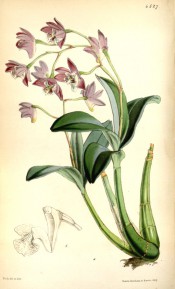Dendrobium kingianum Bidwill ex Lindl.
Frost-tender, evergreen, epiphytic or lithophytic orchid with narrow, conical, pseudobulbs, to 55cm long, with ovate leaves, to 10cm long, and racemes, to 15cm long, of fragrant, pink to deep mauve, occasionally white, flowers, to 4cm across, produced from the pseudobulb tips in spring. [RHSE, Jones, FNSW, Pridgeon, Hortus].
Horticultural & Botanical History
Discovered by John Bidwill, the first specimens were taken by him to England and first flowered at Loddiges’ nursery in 1844. The Botanical Register reports that ‘this curious epiphyte was bought by the Messrs. Loddiges at the sale of Mr. Bidwill’s New Holland plants.’ [BR misc.18/1844, Gard. Chron. 1845].
‘The Royal Gardens of Kew are indebted to our excellent friend Mr. Bidwill for specimens of this rare Dendrobium, which he detected in Australia, we presume in the interior, and which were sent to Europe in 1844. Dr. Lindley refers it to a group of Dendrobium, corresponding to the genus Desmotriccum of Blume, especially characterized as having “root-shaped, jointed, bulbiferous stems,” but which he does not consider to be possessed of characters sufficient to constitute a genus.’ [BM t.4527/1850]. MB p.97/1845.
History at Camden Park
Listed in the 1850 and 1857 catalogues [O.19/1850]. Originally collected by John Bidwill at the Gloucester Buckets. Macarthur probably obtained it from Bidwill or when on a collecting trip around Port Stephens with Bidwill and Philip Parker King, after whom it was named.
Notes
Published Jan 25, 2010 - 04:26 PM | Last updated Jul 28, 2010 - 03:53 PM
| Family | Orchidaceae |
|---|---|
| Category | |
| Region of origin | Eastern Australia |
| Synonyms |
|
| Common Name | Pink rock orchid |
| Name in the Camden Park Record |
Dendrobium Kingianum |
| Confidence level | high |


